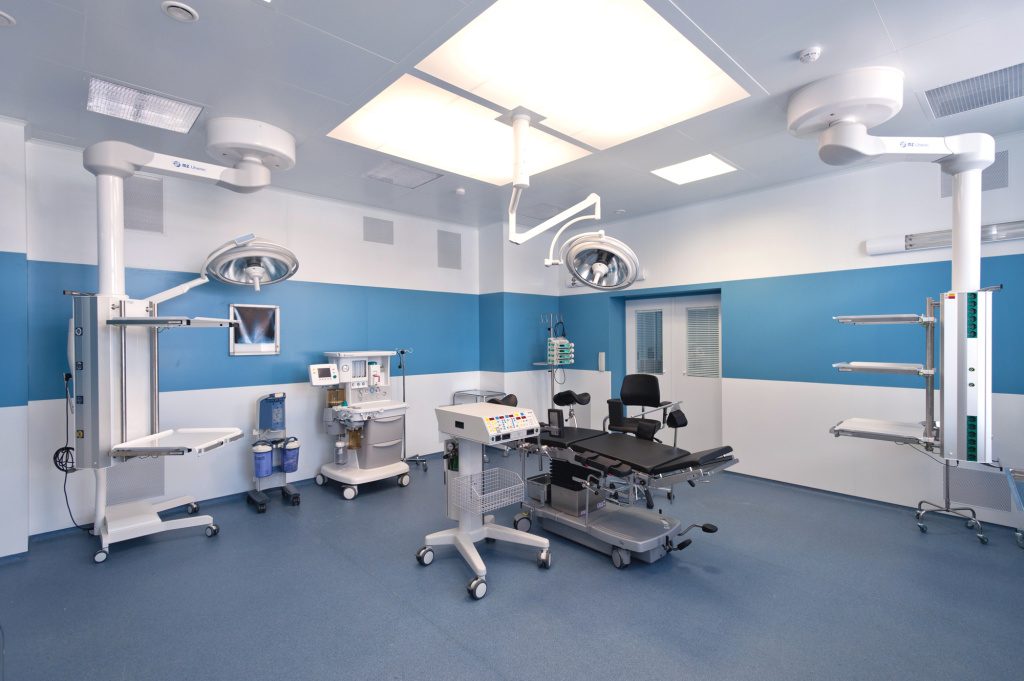
The Importance of Laminar Airflow in Operating Rooms
Operating rooms, one of the most critical points in healthcare services, must be designed as sterile and controlled environments where infection risk is minimized. In these areas, not only building physics but also indoor air quality, particle control, and microbiological safety require advanced engineering solutions.
In this context, the proper design and implementation of HVAC systems are among the factors that directly affect the success of the operating room. Especially, laminar airflow is critically important to reduce infection risk, protect the surgical field, and maintain hygienic conditions continuously.
What is Laminar Flow?
Laminar airflow is a type of flow where air moves with low turbulence, in parallel and at a constant speed, usually in one direction from top to bottom. In this system, air:
-
Flows at low speed (0.2–0.4 m/s),
-
Moves along parallel airflow lines without changing direction,
-
Has minimal microorganism and particle transmission.
Laminar flow is directed vertically from the ceiling surface to the operating room floor through HEPA-filtered vents or laminar air flow units designed to protect the surgical area. This way, air sweeps contamination away from top to bottom.
Why is Air Quality Vital in Operating Rooms?
Since surgical operations involve direct intervention on body tissues, any microorganism coming from the external environment poses an infection risk for the patient. Particularly:
-
Postoperative infections increase hospital stay duration,
-
Antibiotic-resistant bacteria (e.g., MRSA) complicate the treatment process,
-
Exposure risk exists for surgeons and healthcare personnel as well.
Therefore, the operating room environment must be kept under strict control for particles, temperature, humidity, pressure, and airflow direction to prevent airborne infections.
Benefits of Laminar Flow in Operating Rooms
-
Reduces Microbial Contamination
HEPA-filtered laminar systems filter out 99.97% of airborne particles sized 0.3 microns, protecting the surgical field. -
Prevents Turbulence
Turbulent flows seen in conventional ventilation systems increase particle and microorganism transmission; laminar systems eliminate this risk. -
Keeps the Surgical Field Sterile
Especially important for long and risky operations such as orthopedic, cardiovascular, and neurosurgery, where continuous clean air washing increases success rates. -
Supported by Pressure Difference and Air Direction
Operating rooms are maintained under positive pressure relative to surrounding areas, so air flows outwards and contamination cannot enter.
System Design: Engineering Criteria
For a laminar airflow system to be effective, the following engineering criteria must be met:
-
Air Change Rate (ACH)
Minimum 20–25 ACH in operating rooms, reaching up to 60 ACH in laminar systems. -
Air Velocity
Air exit velocity from ceiling HEPA filters should be 0.25–0.35 m/s with a stable velocity profile depending on horizontal or vertical flow. -
HEPA Filters (H13 / H14 Class)
Filtration capacity of 99.97% or higher, with filters easily accessible and monitorable. -
Space Planning
The surgical clean zone should be directly under ceiling vents or laminar air flow units, with personnel passages and equipment placement planned not to obstruct airflow. -
Ceiling-to-Floor Airflow
Vertical laminar airflow system is preferred, with contaminated air exhausted through the floor.
Energy Efficiency and Sustainability
Laminar systems operate with high air volume and thus consume more energy than traditional systems. For energy savings, the following should be implemented:
-
Variable air volume (VAV) fan systems,
-
Energy recovery units,
-
Intelligent automation systems that operate based on surgery schedules,
-
Filter clogging monitoring and timely maintenance,
-
Energy optimization through heat recovery.
These applications allow laminar flow systems to combine high hygiene levels with energy efficiency.
Legal Regulations and Standards
Laminar airflow operating rooms must comply with various national and international standards, such as:
-
TS EN ISO 14644-1: Cleanrooms and air cleanliness classes,
-
TS EN 12128 / EN 12469: Ventilation for biosafety areas,
-
DIN 1946-4: Operating room HVAC system design,
-
ASHRAE 170: Ventilation design guide for healthcare facilities,
-
Ministry of Health Operating Room Regulation.
Compliance not only reduces infection risks but also prevents administrative and legal issues during inspections.
Laminar Flow and Hybrid Systems
With advancing technology, hybrid operating rooms combining imaging systems and surgical equipment are becoming more common. In these areas, laminar flow systems must:
-
Work compatibly with medical imaging devices,
-
Be zoned to distribute heat load,
-
Be managed modularly with precise control systems.
Smart HVAC systems can adapt laminar flow with automatic mode switches according to surgery type and personnel.
Hygienic Success is Hidden in Engineering
Infection control in operating rooms depends not only on sterile surgical techniques but also on engineering-based environmental planning. Laminar airflow is one of the most effective systems that meet the hygienic standards required by modern medicine.
“The success rate of an operating room is directly proportional to the quality of its airflow.”
A properly designed, well-filtered, and energy-efficient laminar airflow system enhances surgical success and maximizes patient safety.
İlker KURAN
Alperen Engineering Ltd.







